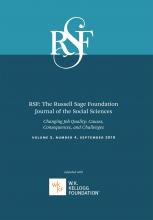Abstract
How are changes in the low-wage labor market affecting the mobility of workers out of low-wage work? I investigate changes in the wage mobility of workers starting employment spells in low wages using the Panel Study of Income Dynamics from 1968 to 2014 and discrete-time event history analysis. About half of all low-wage workers move to better wages within four years. Effects on mobility rates are significant by age, gender, race, education, occupation, and job characteristics. Mobility rates out of low-wage work have declined since the late 1990s. Little progress has been made in closing the gaps in mobility for women and nonwhites over time. I find evidence for the decline of firm internal labor markets and lower mobility for part-time workers over time.
- © 2019 Russell Sage Foundation. Schultz, Michael A. 2019. “The Wage Mobility of Low-Wage Workers in a Changing Economy, 1968 to 2014.” RSF: The Russell Sage Foundation Journal of the Social Sciences 5(4): 159–89. DOI: 10.7758/RSF.2019.5.4.06. I am grateful to Arne Kalleberg and Ted Mouw for many conversations that led to this article. I would like to thank David Howell, conference participants, and the three anonymous reviewers for constructive feedback. The collection of data used in this study was partly supported by the National Institutes of Health under grant number R01 HD069609 and R01 AG040213 and the National Science Foundation under award numbers SES 1157698 and 1623684. Direct correspondence to: Michael A. Schultz at schultzm{at}live.unc.edu, 155 Hamilton Hall, CB#3210, Chapel Hill, NC 27599
Open Access Policy: RSF: The Russell Sage Foundation Journal of the Social Sciences is an open access journal. This article is published under a Creative Commons Attribution-NonCommercial-NoDerivs 3.0 Unported License.






